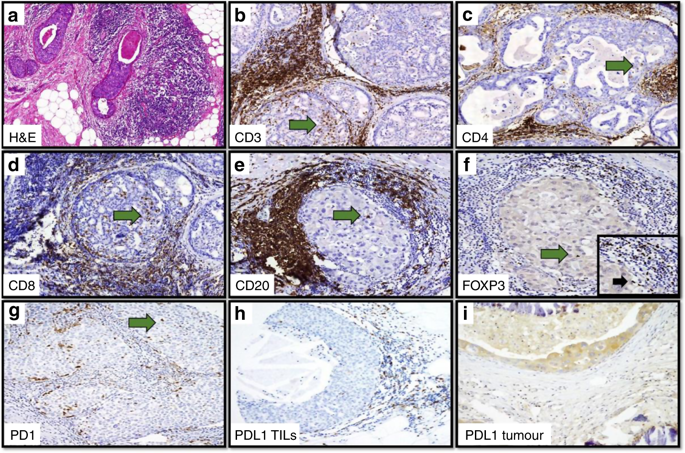当前位置:
X-MOL 学术
›
Br. J. Cancer
›
论文详情
Our official English website, www.x-mol.net, welcomes your
feedback! (Note: you will need to create a separate account there.)
The prognostic significance of immune microenvironment in breast ductal carcinoma in situ.
British Journal of Cancer ( IF 6.4 ) Pub Date : 2020-03-17 , DOI: 10.1038/s41416-020-0797-7 Michael S Toss 1, 2 , Asima Abidi 1 , Dorothea Lesche 3, 4 , Chitra Joseph 1 , Sakshi Mahale 3 , Hugo Saunders 3 , Tanjina Kader 3, 4 , Islam M Miligy 1 , Andrew R Green 1 , Kylie L Gorringe 3, 4 , Emad A Rakha 1
British Journal of Cancer ( IF 6.4 ) Pub Date : 2020-03-17 , DOI: 10.1038/s41416-020-0797-7 Michael S Toss 1, 2 , Asima Abidi 1 , Dorothea Lesche 3, 4 , Chitra Joseph 1 , Sakshi Mahale 3 , Hugo Saunders 3 , Tanjina Kader 3, 4 , Islam M Miligy 1 , Andrew R Green 1 , Kylie L Gorringe 3, 4 , Emad A Rakha 1
Affiliation

|
BACKGROUND
The role of different subtypes of tumour infiltrating lymphocytes (TILs) in breast ductal carcinoma in situ (DCIS) is still poorly defined. This study aimed to assess the prognostic significance of B and T lymphocytes and immune checkpoint proteins expression in DCIS.
METHODS
A well characterised DCIS cohort (n = 700) with long-term follow-up comprising pure DCIS (n = 508) and DCIS mixed with invasive carcinoma (IBC; n = 192) were stained immunohistochemically for CD20, CD3, CD4, CD8, FOXP3, PD1 and PDL1. Copy number variation and TP53 mutation status were assessed in a subset of cases (n = 58).
RESULTS
CD3+ lymphocytes were the predominant cell subtype in the pure DCIS cohort, while FOXP3 showed the lowest levels. PDL1 expression was mainly seen in the stromal TILs. Higher abundance of TILs subtypes was associated with higher tumour grade, hormone receptor negativity and HER2 positivity. Mutant TP53 variants were associated with higher levels of stromal CD3+, CD4+ and FOXP3+ cells. DCIS coexisting with invasive carcinoma harboured denser stromal infiltrates of all immune cells and checkpoint proteins apart from CD4+ cells. Stromal PD1 was the most differentially expressed protein between DCIS and invasive carcinoma (Z = 5.8, p < 0.0001). Dense TILs, stromal FOXP3 and PDL1 were poor prognostic factors for DCIS recurrence, while dense TILs were independently associated with poor outcome for all recurrences (HR = 7.0; p = 0.024), and invasive recurrence (HR = 2.1; p = 0.029).
CONCLUSIONS
Immunosuppressive proteins are potential markers for high risk DCIS and disease progression. Different stromal and intratumoural lymphocyte composition between pure DCIS, DCIS associated with IBC and invasive carcinoma play a potential role in their prognostic significance and related to the underlying genomic instability. Assessment of overall TILs provides a promising tool for evaluation of the DCIS immune microenvironment.
中文翻译:

免疫微环境对乳腺导管原位癌的预后意义。
背景肿瘤浸润淋巴细胞(TIL)不同亚型在乳腺导管原位癌(DCIS)中的作用仍不清楚。本研究旨在评估 DCIS 中 B 和 T 淋巴细胞以及免疫检查点蛋白表达的预后意义。方法 对特征明确的 DCIS 队列 (n = 700) 进行长期随访,包括纯 DCIS (n = 508) 和混合浸润性癌 (IBC;n = 192),对 CD20、CD3、CD4、CD8 进行免疫组织化学染色、FOXP3、PD1 和 PDL1。在一组病例 (n = 58) 中评估了拷贝数变异和 TP53 突变状态。结果 CD3+ 淋巴细胞是纯 DCIS 队列中的主要细胞亚型,而 FOXP3 的水平最低。 PDL1 表达主要见于基质 TIL。较高丰度的 TIL 亚型与较高的肿瘤分级、激素受体阴性和 HER2 阳性相关。突变的 TP53 变异体与较高水平的基质 CD3+、CD4+ 和 FOXP3+ 细胞相关。与浸润性癌共存的 DCIS 具有除 CD4+ 细胞之外的所有免疫细胞和检查点蛋白的更密集的基质浸润。基质 PD1 是 DCIS 和浸润性癌之间差异最大的表达蛋白 (Z = 5.8, p < 0.0001)。致密 TIL、基质 FOXP3 和 PDL1 是 DCIS 复发的不良预后因素,而致密 TIL 与所有复发(HR = 7.0;p = 0.024)和侵袭性复发(HR = 2.1;p = 0.029)的不良结局独立相关。结论 免疫抑制蛋白是高风险 DCIS 和疾病进展的潜在标志物。 纯 DCIS、与 IBC 相关的 DCIS 和浸润性癌之间不同的基质和肿瘤内淋巴细胞组成在其预后意义中发挥潜在作用,并与潜在的基因组不稳定性相关。总体 TIL 的评估为评估 DCIS 免疫微环境提供了一个有前途的工具。
更新日期:2020-03-19
中文翻译:

免疫微环境对乳腺导管原位癌的预后意义。
背景肿瘤浸润淋巴细胞(TIL)不同亚型在乳腺导管原位癌(DCIS)中的作用仍不清楚。本研究旨在评估 DCIS 中 B 和 T 淋巴细胞以及免疫检查点蛋白表达的预后意义。方法 对特征明确的 DCIS 队列 (n = 700) 进行长期随访,包括纯 DCIS (n = 508) 和混合浸润性癌 (IBC;n = 192),对 CD20、CD3、CD4、CD8 进行免疫组织化学染色、FOXP3、PD1 和 PDL1。在一组病例 (n = 58) 中评估了拷贝数变异和 TP53 突变状态。结果 CD3+ 淋巴细胞是纯 DCIS 队列中的主要细胞亚型,而 FOXP3 的水平最低。 PDL1 表达主要见于基质 TIL。较高丰度的 TIL 亚型与较高的肿瘤分级、激素受体阴性和 HER2 阳性相关。突变的 TP53 变异体与较高水平的基质 CD3+、CD4+ 和 FOXP3+ 细胞相关。与浸润性癌共存的 DCIS 具有除 CD4+ 细胞之外的所有免疫细胞和检查点蛋白的更密集的基质浸润。基质 PD1 是 DCIS 和浸润性癌之间差异最大的表达蛋白 (Z = 5.8, p < 0.0001)。致密 TIL、基质 FOXP3 和 PDL1 是 DCIS 复发的不良预后因素,而致密 TIL 与所有复发(HR = 7.0;p = 0.024)和侵袭性复发(HR = 2.1;p = 0.029)的不良结局独立相关。结论 免疫抑制蛋白是高风险 DCIS 和疾病进展的潜在标志物。 纯 DCIS、与 IBC 相关的 DCIS 和浸润性癌之间不同的基质和肿瘤内淋巴细胞组成在其预后意义中发挥潜在作用,并与潜在的基因组不稳定性相关。总体 TIL 的评估为评估 DCIS 免疫微环境提供了一个有前途的工具。










































 京公网安备 11010802027423号
京公网安备 11010802027423号